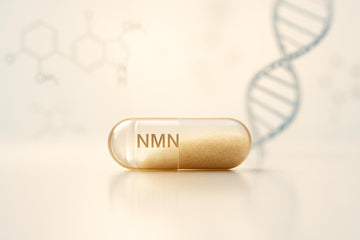Disclaimer: This article is only for information purposes and does not replace medical advice. Always consult a doctor before starting the use of supplements.
Last updated: August 2025
Author:
Daniel Lazarevic
Reviewed by:Simon Sinclair, PHD, professor of genetics
Long -term effects of NMN - what the research says so far (2025)
Summary in brief
- Nmn Raises NAD⁺ levels and can affect energy, cell function and aging.
- Animal studies Shows improved metabolism, physical function and protection against age -related diseases.
- Human studies are promising but small and short -lived.
- Security: Doses up to 900 mg/day are tolerated in the short term; Long -term security not established.
- Knowledge gaps: Long -term data, optimal dose, differences between groups.
What is NMN?
NMN (nicotinamide mononucleotide) is a precursor to Nad⁺, a coenzyme central to energy conversion, DNA repair and cell health. Nad⁺ levels drop with age. Supplements such as NMN are investigated for a potential role in healthy aging.
Current research on long -term use of NMN
Summary of studies
| Study | Population | Dose | Length | Results | Source |
|---|---|---|---|---|---|
| Mills et al. (2016) | Mice | 100–300 mg/kg | 12 months | Improved metabolism, reduced weight gain, no toxicity | Pmid: 28703895 |
| Long et al. (2019) | Alzheimer model (mice) | ≈300 mg/kg | 6 months | Improved mitochondrial function, protection against cognitive decline | Pmid: 31415723 |
| Yoshino et al. (2021) | 25 women (prediabetes) | 250 mg/day | 10 v | Improved insulin signaling | Pmid: 33509948 |
| Kim et al. (2021) | Amateur runner | 600 mg/day | 6 v | Increased aerobic capacity | Pmid: 33782469 |
| Vrablic et al. (2022) | 80 adults | 300–900 mg/day | 60 d | ↑ Nad⁺ levels, ↑ Endurance, good tolerance | Pmid: 36243185 |
Findings from animal studies
- Reduced age -related weight gain and improved insulin sensitivity.
- Improved mitochondrial function and protection in neurodegenerative models.
Results from human studies
- 250 mg/day improved the muscle insulin signaling in postmenopausal women.
- 600 mg/day aerobic capacity increased in runners.
- Up to 900 mg/day for 60 days, Nad⁺ and endurance increased, with good tolerance.
Research gaps and restrictions
- Long -term security: Effects in multi -year use are unknown.
- Optimal dose: Varies between studies; Not established.
- Populations: Differences due to gender, age and health condition are insufficiently mapped.
- Limited documentation: Get registered NMN studies on clinicaltrials.gov relative no.
"Marketing in the area is several steps ahead of scientific research, which emphasizes the need for extensive, long -term trials." - Dr. Taylor C. Wallace
Security profile and dosage
Reported side effects
- Human, short term: Generally well tolerated up to 900–1250 mg/day.
- Animals, high doses: Risk of liver effects and kidney damage.
Recommendations
- Stay within 250-500 mg/day About at all, in consultation with doctors.
- Over 900 mg/day only after medical assessment.
- Be especially careful in underlying diseases or drug treatment.
How NMN works in the body
NMN is converted to NAD⁺ which activates sirtuins and supports energy conversion, DNA repair and inflammation control. Animal data shows improved mitochondrial function and reduced oxidative stress.
Practical advice to consumers
- Choose quality: Third -party testing and clear purity.
- Certifications: for example U.S. Pharmacopeia/NSF there applicable.
- Lifestyle first: Diet, exercise, sleep. NMN is not a compensation.
- Medical advice: Consult healthcare professionals before starting/raising.
Conclusion
NMN is promising for cell health and age -related processes. Human long -term data is missing. Use with caution, choose high quality and involve healthcare personnel.
Faq
Is NMN safe to take daily?
Short -term studies indicate good tolerance up to 900–1250 mg/day. Long -term security in humans is unclear. Follow doctors' advice.
How does NMN differ from no?
Both are NAD⁺ precursors. Comparative long -term data and bioavailability between NMN and no are limited.
What are the risks at high doses?
Animal data points to liver and kidney influence at very high doses. Stick to documented levels and consult with doctors.
Sources
- Mills KF et al. Cell Metab. 2016. PMID: 28703895
- Long an et al. Front Aging Neurosci. 2019. PMID: 31415723
- Yoshino m et al. Science. 2021. PMID: 33509948
- Kim C et al. J INT soc sports nuts. 2021. PMID: 33782469
- Vrablic m et al. Nutrients. 2022. PMID: 36243185
- Clinicaltrials.gov - Search Term “NMN”
Related Posts
- Best dietary supplements for mental clarity and scheduling
- The nanotechnology of the future for aging cells
- Exercise and daily rhythm: What does the research say?
- How your dietary impact growth hormone production


